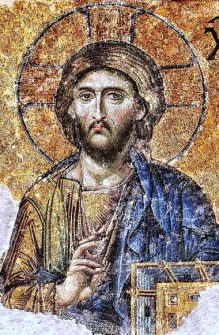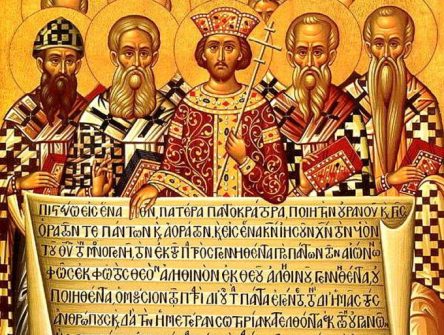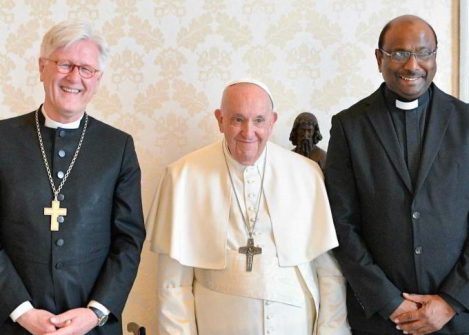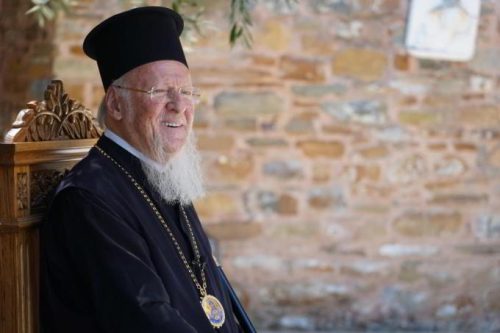The Council of Nicaea. The Creed of Hope.

This year marks the 1,700th anniversary of the Council of Nicaea (325 AD). It was the first ecumenical gathering to seek a fuller understanding of the faith. Beyond its theological significance, it has also shown that common discernment is a way of hope for a pilgrim Church of the Jubilee.
In 1300, Pope Boniface VIII surrendered to the faith shown by the throngs of pilgrims who had spontaneously flocked to Rome and granted them the Jubilee indulgence, namely, the remission of temporal pains due to sin. Since then, the Catholic Church has celebrated a Jubilee Year and, from 1470 onwards, not every 100 or 50 years, but every 25 years. The emphasis is on forgiveness and reconciled relationships with God, oneself and one another.
The 2025 Jubilee Year ‘Pilgrims of hope’ looks to a future with a message of hope. Hope is not synonymous with illusion or optimism based on world forces. Nor is it escapism, denial or resignation amidst the suffering in the world.

Mosaic of Christ Pantocrator (“ruler over all”) from the Hagia Sophia in Istanbul, Turkey. Photo: Dianelos Georgoudis
The message of hope for the future is fundamentally one of trust in God’s faithful commitment. Faith, trust and fidelity have the same root: steadfastness.
The Jubilee of Hope strengthens the joy of Christians, assured of God’s unwavering love for all He has created and in whom He places hope. God hopes that His image in us will be revealed, strengthened and will radiate for the world to see.
In his first encyclical, Lumen fidei, Pope Francis presented faith as a “memory of the future”, memoria futuri, which is not fixed on a bygone past, but it is the evocation of a promise, in Abraham and then in Jesus Christ (LF §9, 10, 15). Faith and hope are based on God’s commitment, in His Word and in history. Hope is God’s precious gift to men and women; a gift that makes them grow in self-confidence and prevents them from discouragement or resignation.In 2025, we commemorate the 1700th anniversary of the Council of Nicaea, the first ecumenical council to formulate faith in Jesus, true God and true man, a faith professed by all Christians. The circumstances, debates and decrees of this Council have left a lasting mark on Christian history. How can they guide their hope for today?
Circumstances surrounding the Council of Nicaea
The first council was undoubtedly the meeting of the apostles and ancients in Jerusalem, (Acts 15), gathered to decide a crucial question: should non-Jewish converts be circumcised and made to obey the Law of Moses in order to become Christians? Various local councils took place after this first council, before Emperor Constantine convened a general council at Nicaea. Why did he call for it?
Priest Arius, a theologian from Alexandria, Egypt, had stated in 318 – in defiance of his bishop Alexander’s doctrine – that Jesus Christ, though indeed the Son of God, was not God Himself.

Icon depicting the Emperor Constantine and the bishops of the First Council of Nicaea (325) holding the Niceno–Constantinopolitan Creed of 381. Reproduction: Médiathèque chrétienne.
According to Arius, Jesus Christ was created by God the Father at a specific moment in time. To infer that Jesus was God would imply, for Arius’ views, to overshadow the uniqueness of God and the divinity of the Father. He maintained that Jesus was a creature subordinated to the Father, and that there was a time when the Son was non-existent. This is tantamount to denying the eternal existence of the Son. The quarrel between priest and bishop escalated, and local councils failed to settle it. Hence Emperor Constantine decided to convoke an ecumenical council in Nicaea, in present-day Turkey. The emperor’s involvement in religious matters has been criticized as a prelude to confusion between or interferences by religious and political spheres. The military means used in this turbulent period were indeed shocking.
The edict of 313, which put an end to Christian persecution, and the convening of the Council of Nicaea in 325, were also means of guaranteeing a certain form of peace and progress towards unity.
Some 300 bishops were present at Nicaea to examine Arius’ position as well as priests, including Arius, deacons, theologians and philosophers – some of these were not even Christians.
Based on the Gospel, the Council affirmed that Jesus was truly man and truly God, and that He saved humanity from sin and death through His two natures united in His one person.
Jesus is not just a better, superior or exemplary man. True God, consubstantial with the Father, and incarnate in the Virgin Mary, He communicates divine life, reconciles, heals in depth and saves humankind, which no man can do. Christ, the mediator of salvation through His dual nature, is the central affirmation of the Christian faith.

Faith is a truth to be believed, experienced and understood. Photo: WCC
Debates flared up, because what was at stake was not a quarrel about words or currents of thought, but in fact the very heart of the Christian faith. This was still the scandal to Jews and folly to the Greeks which St Paul refers to (1 Cor 1:23). False doctrines have also spread since apostolic times. The Council of Nicaea is called ecumenical for two reasons: firstly, and for the first time, it addressed the Christian world as a whole (oikumene designates the inhabited universe, the known world). Emperor Constantine sent a letter of convocation to all the bishops of the Roman Empire, as well as to a Scythian bishop (the Scythian territory now includes the Ukraine, Belarus and Azerbaijan) and a Persian bishop (Iran). Secondly, its decisions were to be received and applied throughout the Christian world. Arius’ doctrine continued to spread after Nicaea and included bishops among its adherents, but the Trinitarian creed was reaffirmed in 381 at the Council of Constantinople, where it was supplemented by developments on the Incarnation and the Holy Spirit (as God, He is Lord, He gives life; He proceeds from the Father
and, with the Father and the Son, receives the same adoration
and glorification).
Nicaea today
The Church currently recites the Nicene- Constantinople Creed, not the Nicene Creed alone. Nicaea consecrates both the fruitfulness of theological effort in the interpretation of Scripture and the right of the Church gathered in ecumenical council to specify the content of the Christian faith by a dogmatic definition (as occurred with the incorporation of the word ‘consubstantial’ into the creed), which manifests the progress made in the explanation of the Revelation.
The Nicene-Constantinopolitan Creed is used in the liturgy and personally by believers. It is a reliable reference to use when meeting people who ask questions about one’s faith. It also has practical life implications. If God is the creator of all visible beings, how can we regard a person with contempt or hatred? If there is only one Lord Jesus Christ, why create idols (authorities, stars, money, ourselves…)?

Bishop. Dr Heinrich Bedford-Strohm, WCC Moderator, Pope Francis, and Rev. Prof. Dr Jerry Pillay, WCC general secretary, during a visit to the Vatican on 23 March 2023. Photo: Vatican Media
The creed enables Christians to find common ground on a clearly stated basis, including philosophy. Faith is a truth to be believed, experienced and understood. Its authority is recognized in ecumenical dialogue. Protestants agree with the Nicene-Constantinople creed, and at the same time formulate “confessions of faith” specific to their church, updating it, or emphasizing a particular point, but without discrediting it.
The main turning point at Nicaea was to establish that the Church’s major decisions should be taken in ecumenical councils, with representatives from the whole inhabited earth, and not in a sectorized manner. Other theological issues have been debated throughout history (the images of God and the saints at Nicaea II, the Eucharist and ministry at Trent, the renewal of ecclesiology at Vatican II).

His All Holiness Ecumenical Patriarch Bartholomew. This year Orthodox Christians will celebrate Easter together with Catholics and Protestants. Photo: EPpress
The Catholic Church has continued the practice of ecumenical councils, though now convened by the Pope, but without the voting participation of Orthodox and Protestants. The Orthodox held their ecumenical council in Crete in 2016. In October 2024 the synod on synodality proposed an ecumenical synod on mission (Synod Final Document §138).
Ecumenical dialogues have been held for over 60 years on specific points of doctrine. This year Orthodox Christians will celebrate Easter together with Catholics and Protestants. The age-old hope that a common date will be adopted may well be realized, as the still-divided Christians have not given up on this issue.
We are no longer in the logic of Nicaea and its exclusionary anathemas. While there are no emperors convoking ecumenical councils, a common search continues, by synodal means.
The Churches see themselves less as enemies than as partners, and seek to cultivate the exchange of gifts. God’s fundamental promise is the gathering of all humanity into His kingdom of justice and peace. The hope of Christians is unwavering. (Opening of the Council of Nicaea (325) by Emperor Constantine I the Great (foreground) by Cesare Nebbia (c.1536–c.1614). Wikimedia/picryl.com)
Marie-Hélène Robert, OLA



